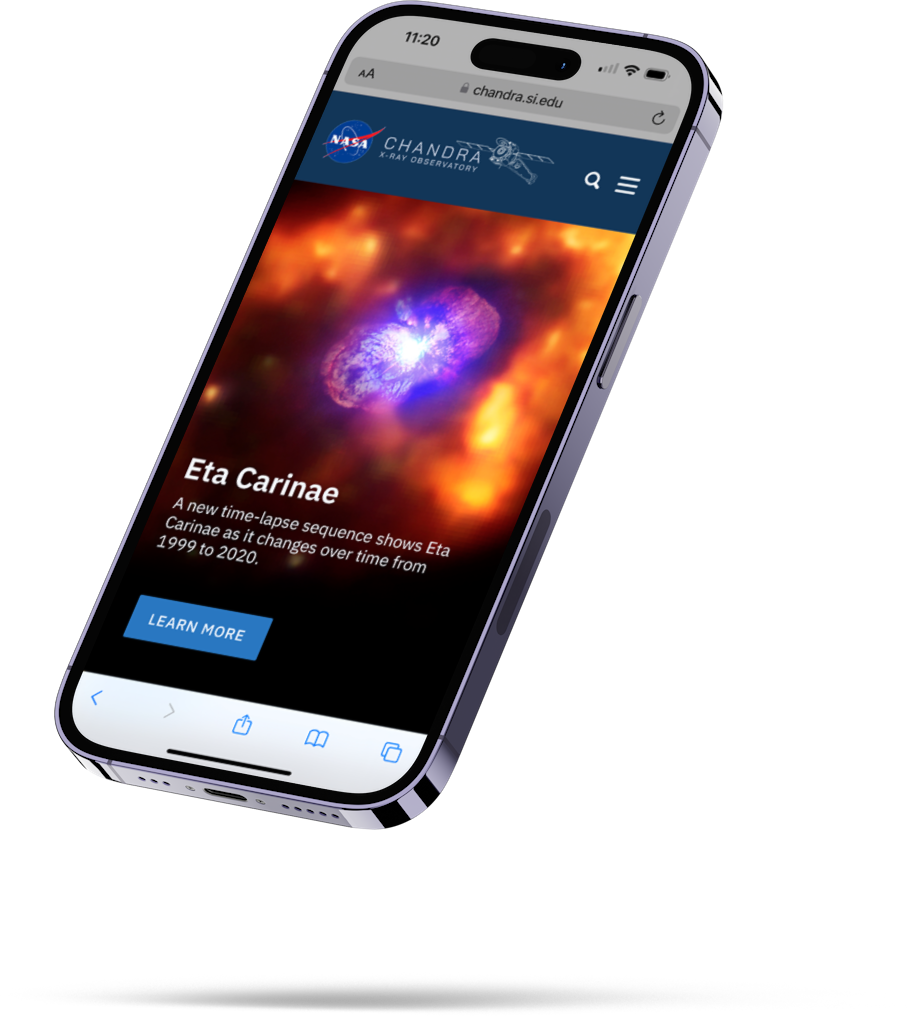
CASE STUDY
Chandra X-ray Observatory
Center for Astrophysics | Harvard & Smithsonian
Website Redesign
The Chandra X-ray Observatory is a space-based telescope that observes the universe in X-rays, providing detailed images and insights into high-energy celestial phenomena. Launched in 1999, it is considered the world's most powerful X-ray telescope.
Celebrating 25 years in space, Chandra has managed an extraordinary library of spectacular imagery, glowing remains of exploded stars, observed the region around the supermassive black hole in the center of our Milky Way, and traced the separation of dark matter from normal matter in the collision of galaxies.
Its mission continues to discover startling new science about our high-energy Universe, but to also serve the research community with its archive, its immense amount of data, and news updates on new discoveries.
We wanted the world to re-discover Chandra through a new lens and a new light.
PRIORITIES
Develop templates in a custom, responsive framework for the Chandra team to make updates and manage content.
Present a new Homepage in a modern experience for visitors to explore Chandra’s mission and press updates.
Update the Photo Album to an easier, more searchable format for displaying media and information.
Provide a more accessible website experience for visitors with a variety of needs, purposes, and devices.
Achieve these priorities ahead of Chandra’s 25th anniversary to welcome new visitors and serve users for years to come.
REQUIREMENTS
Full Stack web development—PHP, MySQL, CSS, Html, Javascript.
Original, custom code for responsive templates
Updated web page designs from approved Adobe XD files to match the new custom framework.
Delivery in 4 months with additional creative direction and design support for launch.
Test functionality of the site and templates with the Chandra team.
Project management, art direction, and design support with documentation.
Template Design
The CXO team had engaged with a developer previous to our involvement. While the team’s internal designer had produced early concepts to achieve leadership’s approval, development struggled to meet the CXO’s specific needs and the project stalled.
DESIGN UPDATE
We began by determining the best foundation for a responsive, scalable, efficient public-facing web application. Popular Drupal and Bootstrap frameworks, although fully capable, could not be deployed in order to provide a custom toolkit independent from future required updates.
Then we needed to update the approved designs to match the responsive grid and apply the UX principles and accessibility features with a design system.
CUSTOM FRAMEWORK
The templates were built with flexibility in mind to work across multiple browsers and to display content in a responsive layout. With those objectives in mind we developed the templates using a CSS Flexbox framework.
All of our templates would have three primary and dynamic sections—header, main body (4 unique templates/grids), and footer. This ensures that the layout/design of each web page created from these templates remain consistent.
MODULAR & FUTURE-PROOF
All three of the sections were created as their own files and included for additional, future web pages created from these templates. This would allow the CXO team to make a content edit to one file and be available in all templates that include these files. Edits to these files would primarily be in the main body and footer navigation to include URLs for each navigation item.
Chandra’s Future
NASA’s Chandra X-ray Observatory is managed by the Center for Astrophysics and operated by the Smithsonian Astrophysical Observatory. It’s both a federal program and a private foundation that often suffers from political budget positioning. In 2025, along with several space science programs, Chandra is facing cancellation. The launch of the website redesign and redevelopment was defunded.
America is surrendering its leadership in astrophysics research. Why is that a big deal?
Astrophysics often leads to the development of new technologies that have practical applications for industry. CCD cameras used in smartphones, GPS systems, and medical imaging techniques are all examples of technology transfer from astrophysics. It probes the limits of known physics, pushing the boundaries of quantum mechanics and general relativity.
With this budget, Chandra X-ray’s termination will be expedited, Hubble’s aging crisis will be neglected, and Webb will be the lone American observatory in space. Follow the effort to save Chandra X-ray Observatory’s mission.
Header photo: ESO/WFI (Optical); MPIfR/ESO/APEX/A.Weiss et al. (Submillimetre); NASA/CXC/CfA/R.Kraft et al. (X-ray)




